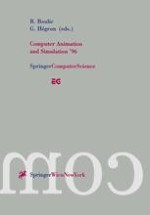The 14 papers in this volume vividly demonstrate the current state of research in real-time animation. Half of the papers are dedicated to algorithm allowing the real-time animation of complex articulated structure in particular (humans, legged robots, plants) and of dynamic scenes in general. The proposed approaches cover from motion capture to motion reusability which are essential issues for high-end applications as 3D games, virtual reality, etc. Other topics treated are motion management for fast design of realistic movements, 2D and 3D deformations, and various optimization techniques for simulation (adaptive mass-spring refinement, huge particule systems).
